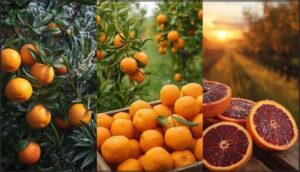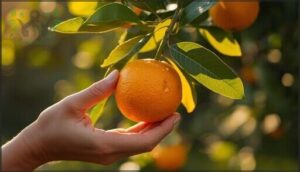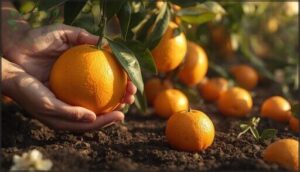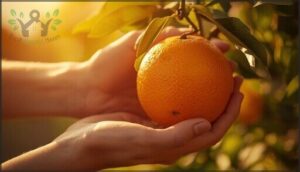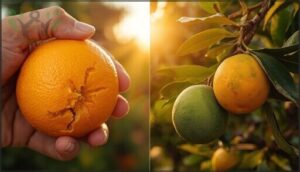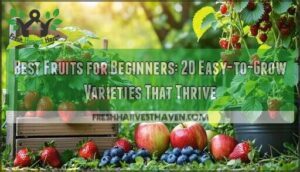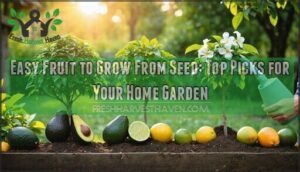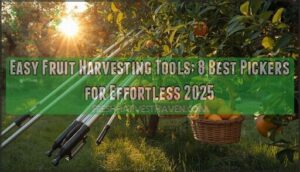This site is supported by our readers. We may earn a commission, at no cost to you, if you purchase through links.

Ask any seasoned grower about the best time to harvest oranges, and you’ll probably hear a story about a perfect morning—cool air, golden fruit, and a fragrance that lingers on your hands long after the work is done. But here’s the twist: those glossy, bright oranges hanging on the tree might not be ready, no matter how good they look.
Color can fool you, and timing isn’t just a matter of flipping the calendar. If you want oranges that taste like sunshine and last on your counter, you’ll need to read the tree as much as the season. Here’s how to get it right.
Table Of Contents
- Key Takeaways
- Key Factors Influencing Orange Harvest Timing
- Harvest Times for Popular Orange Varieties
- Signs of Ripeness Beyond Color
- How to Test Oranges for Peak Ripeness
- Best Techniques for Harvesting Oranges
- Storing and Preserving Freshly Picked Oranges
- Common Mistakes When Harvesting Oranges
- Frequently Asked Questions (FAQs)
- Conclusion
Key Takeaways
- Harvest timing depends on taste, smell, and firmness rather than peel color alone, since warm nights can keep ripe oranges green while cool temperatures trigger orange coloring even before the fruit is ready.
- Different orange varieties have distinct harvest windows—Navels peak from January to April, Valencias require about 14 months after flowering and harvest in spring, while Satsumas and Clementines ripen as early as October through January.
- The most reliable ripeness test is conducting a taste test for balanced sweetness and acidity, combined with checking for a strong citrusy fragrance at the stem and firm, heavy fruit that springs back slightly when squeezed.
- Proper harvesting techniques—using gentle hand-twisting or clippers for thin-skinned varieties, avoiding rough handling, and respecting variety-specific timing—protect fruit quality and extend storage life up to 2-3 months when refrigerated.
Key Factors Influencing Orange Harvest Timing
Harvest timing for oranges isn’t as straightforward as watching them turn bright orange. Several factors shape when your fruit is truly ready to pick. Let’s look at what really makes the difference.
Climate and Temperature Effects
If you’re wondering why oranges ripen differently across regions, it’s all about climate. Warm Mediterranean climates support longer maturation periods, while tropical climates speed things up, often at the expense of fruit quality. Here are three key factors affecting orange ripeness:
- Night Temperatures
- Regional Weather and microclimate
- Maturation Period and shifting Harvest Windows
The impact of climate on fruit is undeniable; in Florida, citrus greening disease affects over 90% of orange groves.
Nighttime Temperatures and Fruit Color
When night temperatures dip between 8°C and 15°C, oranges get their vivid peel coloration—thanks to active carotenoid synthesis and color development. In warmer regions, fruit color stays patchy or green, even when the orange is ripe inside. Peel regreening can happen if nights warm up again, so regional variations and genetic responses keep you guessing when determining orange ripeness.
To improve the coloring, the degreening process can be used to stimulate color change.
Maturation Period After Flowering
Don’t let a bright peel fool you—fruit maturity hinges on the Flowering-to-Harvest Duration, not just color.
Oranges spend 6 to 12 months developing after flowering, with Heat Unit Impact and Climate Acceleration speeding up fruit ripening in warmer regions.
Varietal Maturation means some oranges ripen sooner, so use fruit maturity indicators, not just the calendar, for determining fruit ripeness.
Impact of Growing Region
Now, timing isn’t just about the calendar—it’s about where your fruit’s growing. Climate Adaptation and Regional Microclimates shape how long oranges take to ripen. Soil Composition, Water Availability, and Disease Prevalence can shift harvest dates by months.
For example, fruit growing locations in California and Florida see different seasonal orange harvests, even for the same orange variety ripeness.
Harvest Times for Popular Orange Varieties
Each orange variety has its own unique harvest window, shaped by climate and growing conditions. Knowing when your favorite type is ready can make all the difference in taste and quality.
Here’s a quick guide to help you match the right season to the right orange.
Navel Orange Harvest Season
Did you know California Navels reach Peak Navel Quality from January to April, during the height of Winter Sweetness? With increased production reported for 2025, navel oranges are best picked when firm, fragrant, and heavy for their size.
Seasonal variations matter—wet falls can nudge harvest dates earlier. Use gentle orange harvesting techniques to keep fruit undamaged.
Valencia Orange Harvest Window
When spring rolls in, Valencia oranges step into the spotlight, requiring about 14 months after flowering to reach legal maturity. Their harvest timing is key—delayed harvests can lower yield and grade, especially during crop overlap and market shift. For best results, use careful orange harvesting techniques:
- Check for firmness
- Look for heavy fruit
- Avoid damaged skin
- Taste-test for sweetness
- Harvest before next bloom
Cara Cara and Pineapple Sweet Oranges
Cara Cara oranges steal the show with their pink flesh and balanced flavor profiles, while Pineapple sweet oranges offer a classic winter harvest experience. For peak sweetness, aim for late February or early March—don’t rely on color alone. Use smell and taste to guide you.
Here’s a quick reference:
| Variety | Peak Sweetness | Best Uses |
|---|---|---|
| Cara Cara | Late Winter | Fresh Eating |
| Pineapple Sweet | Dec–Feb | Juicing, Snacks |
| Pink Flesh | Feb–Mar | Salads, Desserts |
Satsuma, Clementine, and Kishu Timelines
Ever wondered why Satsuma harvest kicks off before Thanksgiving? Early varieties like Silverhill Satsuma and Xie-shan mandarin hybrids ripen in October, while Clementine oranges reach peak maturity from November to January.
Kishu ripening is even earlier—October’s their moment. When tracking orange variety harvesting times, pay attention: these mandarins are your signal that harvest time is truly underway.
Signs of Ripeness Beyond Color
If you’ve ever picked an orange just because it looked bright and perfect, you know looks can be deceiving. There’s more to ripeness than what you see on the outside.
Here’s what else you should pay attention to before you start harvesting.
Why Color Alone is Unreliable
Think orange color means ripe fruit? Not so fast. Consumer color bias leads many to judge by looks, but internal vs. external quality often disagrees.
Factors affecting fruit color include:
- Temperature color variation—warm nights keep peels green
- Scientific color perception—optical illusions fool the eye
- Regreening in Valencia oranges
- Integrated harvest practices—taste, weight, and firmness matter more
Understanding orange ripening process goes beyond skin deep.
Smell and Fragrance Indicators
Ready to trust your nose? The secret to identifying ripe oranges isn’t color—it’s the sweet fragrance right at the stem. Sensory analysis shows aroma compounds like limonene and aldehydes peak when zest intensity is highest.
If you smell a strong, citrusy scent and no overripe odors, you’re set for orange taste testing. Ripe fruit always gives a fragrant smell.
Fruit Drop and Texture Clues
Once your nose confirms a sweet scent, look for fruit drop and texture clues. A low drop rate often means the fruit is nearly ripe—a natural ripening cue.
Harvest observations show firm, slightly springy oranges signal peak juiciness. Each variety offers its own texture ripeness link, so feel for weight and smoothness to guide your harvesting tips and fruit taste.
How to Test Oranges for Peak Ripeness
Testing your oranges for ripeness is easier than you might think. There are a few simple checks you can use to know if the fruit is ready.
Here’s what to look for before you start picking.
Conducting a Taste Test
How can you be certain your oranges have reached their peak? The most reliable method is conducting a simple taste test before you harvest the entire tree. This sensory evaluation reveals fruit flavor better than any visual inspection.
Here’s how to do it right:
- Pick one or two oranges from different branches to get a representative sample
- Use palate cleansing with water between tastings if you’re comparing multiple fruit
- Evaluate the sugar/acid ratio by noting both orange sweetness and tartness
Professional commercial selection processes prioritize fruit taste and fruit sweetness as dominant factors, which is exactly what you should focus on. A properly ripe orange balances pleasant sweetness with enough acidity to create vibrant flavor, not just sugar alone. If your sample tastes bland or overly tart, give the rest of the tree more time. This blinded samples approach—tasting without preconceptions based on color—ensures you’re harvesting at true peak ripeness.
True orange ripeness is revealed by a perfect balance of sweetness and acidity, not just color or sugar alone
Inspecting for Mold or Blemishes
After tasting, you’ll want to check each orange for mold or blemishes—these can sneak up fast and spoil your harvest. Mold detection starts with a careful look for fuzzy patches or odd colors. Use the table below to guide your inspection and keep fruit quality high.
| Mold Type | Blemish Type |
|---|---|
| Green/Blue Mold | Anthracnose |
| Stem-end Rot | Septoria Spots |
| Sooty Mold | Tearstaining |
| Brown Rot | Botrytis Rot |
| Alternaria Rot | Copper Injury |
Evaluating Fruit Firmness
Once you’ve checked for blemishes, squeeze each orange gently—ripe fruit should feel firm and heavy in your hand. Firmness Measurement Tools, like penetrometers or digital testers, help you gauge texture, aligning with Industry Firmness Standards.
Firmness drops as ripeness increases, so consistent Firmness Testing Practices guarantee fruit quality. Technological Advances now make this process faster and more reliable than ever.
Using Smell to Confirm Readiness
When you’re deciding if an orange is truly ripe, lean in and sniff near the stem or scratch the peel—aroma compounds in the essential oils release a strong, citrusy scent if the fruit’s ready.
Olfactory analysis shows that scent intensity is a reliable ripeness cue, often revealing sweetness and flavor before you even take a bite.
Best Techniques for Harvesting Oranges
Once you know your oranges are ripe, the next step is getting them off the tree safely. There are a few tried-and-true methods that make the job easier and protect the fruit.
Here’s how you can harvest your oranges without any fuss.
Hand Picking and Gentle Twisting
Ever wondered why hand picking and gentle twisting remain the best practice for harvesting oranges? This method keeps Fruit Damage Rates low and preserves quality, despite higher Labor Cost. Experienced pickers can reach impressive Picking Capacity, making it a smart choice for premium fruit. Follow these Best Practices for worthwhile Economic Impact:
- Grasp the orange firmly
- Twist gently, don’t yank
- Detach just above the calyx
- Avoid bruising or tearing
- Place fruit in cushioned bins
Using Clippers for Thin-Skinned Varieties
When you’re harvesting citrus fruit with thin skins, clippers are your best friend. This clipper technique minimizes skin damage and boosts harvest efficiency, especially for Valencia and Pineapple sweet oranges.
You’ll notice improved post-harvest quality and fewer fungal issues. Plus, using clippers streamlines the harvesting process and helps keep labor considerations manageable—making every orange count.
Collecting Fallen Oranges Safely
Did you know slippery orchard floors can turn picking oranges from the ground into a balancing act? Before you pick oranges, check for ground condition hazards and wear footwear with good grip for slip prevention.
Stick to proper lifting posture, respect bag weight limits, and take frequent breaks.
Inspect each ripe orange—discard any with broken skin—to keep your harvest safe and high-quality.
Harvesting Oranges From Tall Trees
Standing beneath a towering orange tree, you might wonder, “How do I reach those golden fruits safely?” Here’s your best bet:
- Use a sturdy ladder and check for stability before climbing.
- Try mechanical fruit pickers or extension pruners for extra reach.
- In high-density orchards, fruit drop safety improves—so watch for fallen oranges near tree branches.
Storing and Preserving Freshly Picked Oranges
Once your oranges are off the tree, keeping them fresh is the next big step. The way you store them makes a real difference in how long they last.
Here’s what you’ll want to think about for the best results.
Room Temperature Vs. Refrigeration
If you’re serious about fruit preservation, here’s the bottom line: oranges last 2–4 weeks at room temperature before microbial spoilage and nutritional changes set in. For best humidity and commercial storage, refrigeration keeps oranges fresh up to 90 days.
Check out this quick comparison for storing freshly picked oranges:
| Storage Method | Shelf Life |
|---|---|
| Room Temperature | 2–4 weeks |
| Refrigeration | 2–3 months |
Proper Storage Containers
Regarding orange fruit storage, container material makes a big difference. Mesh bags and perforated plastic bins offer airflow, helping preserve freshness at room temperature.
For home storage, cotton bags delay moisture, while airtight containers work best in the fridge.
Commercial packaging uses stackable boxes for size considerations—just remember, how you store your oranges shapes their shelf life.
Checking for Damage or Decay
Once your oranges are tucked into the right container, regular inspection is the next step in fruit care. Look for visual damage—soft spots, dark fruit blemishes, or fuzzy mold indicators. These signs shorten shelf life and hit market impact hard.
Gently squeeze for firmness; any hint of fungus or excess moisture means it’s time to remove affected fruit.
Tips for Prolonging Freshness
After you’ve weeded out damaged fruit, focus on temperature control and humidity levels—store at 40–45°F with 85–90% humidity. Use mesh bags for better ventilation methods and keep oranges away from ethylene exposure (think apples and bananas).
For longer shelf life, consider nanomaterial coatings or even fruit storage on trees, if conditions allow, preserving oranges for future use.
Common Mistakes When Harvesting Oranges
Even seasoned growers slip up when it comes to picking oranges. There are a few common missteps that can cost you flavor or freshness.
Here’s what you’ll want to watch out for next.
Picking Too Early or Too Late
Ever wondered what happens if you leave oranges on the tree too long or pick them too soon? Flavor development suffers, storage risks soar, and your economic impact takes a hit. Early picking means poor juice quality and more physical defects, while late harvest season leads to soft, bitter fruit.
Knowing how to tell if oranges are ripe is key to avoiding these pitfalls.
Relying Solely on Color
Although a bright orange peel looks tempting, relying solely on color is a classic misstep. Color limitations, climate influence, and genetic factors can leave even ripe, green oranges hidden in plain sight.
Ripeness standards demand more—taste, smell, and sometimes sophisticated technologies. If you want to know how to tell if oranges are ripe, remember: color alone won’t cut it.
Handling Fruit Roughly
Regarding harvesting oranges, rough handling is a fast track to trouble. Bruising impact isn’t just cosmetic—it slashes shelf life, boosts pathogen susceptibility, and drives up harvest losses.
Fruit harvesting tips? Handle gently, avoid tossing or squeezing. Ripe fruit with intact skin keeps its best characteristics, while damaged ones face quick consumer rejection and spoilage.
Overlooking Variety-Specific Timing
If you overlook fruit variety differences, you’ll likely miss peak flavor and waste effort. Cultivar Harvest Charts and Varietal Ripening Differences matter—a Valencia’s Extended Harvest Windows aren’t the same as a Navel’s.
Microclimate Harvest Impact means even neighboring trees can differ. Use fruit harvest charts and check Variety-Specific Brix to time your picking for each orange variety’s best moment.
Frequently Asked Questions (FAQs)
Can oranges be harvested during rainy weather?
Rainy harvest risks aren’t just about wet shoes—fruit sugar levels drop, mold spreads faster, and operational challenges pile up. Economic consequences follow.
For safe harvesting of citrus fruit, delay picking oranges until surfaces dry, and use smart mitigation practices.
Do pests affect the timing of orange harvest?
Pests can trigger early harvest shifts, especially in vulnerable varieties. Pest-driven harvests impact economic returns and fruit quality, forcing growers to adapt management strategies.
Monitoring and culling during the citrus fruit growth process help reduce losses in citrus fruit development.
How does organic farming impact harvest timing?
Don’t put all your oranges in one basket—organic farming shifts harvest timing by up to two weeks, thanks to slower fertilizer timing, tighter pest management, and weather influence.
This affects fruit quality, nutritional changes, and overall sweetness, making choosing the right time essential.
Are there tools to speed up orange harvesting?
Yes, you can speed up harvest oranges using mechanical harvesters, robotic harvesting systems, and handheld picking tools like pruning shears or garden scissors. These methods improve efficiency gains during fruit harvesting while protecting your citrus fruit.
What are the labor requirements for large harvests?
Large-scale orange harvesting demands a substantial seasonal workforce. Brazil employs 40,000-50,000 workers annually, while U.S. citrus relies heavily on migrant labor through H-2A programs.
Labor costs often exceed 30% of production expenses, with harvest productivity averaging 50-57 boxes per picker daily.
Conclusion
Ironically, the best time to harvest oranges isn’t when they look their prettiest—it’s when they taste their truest. Color fades, but flavor doesn’t lie.
By trusting your senses, respecting each variety’s rhythm, and handling fruit with care, you’ll transform every harvest into something worth savoring.
So skip the guesswork, pick with purpose, and let the tree tell you when it’s ready. That’s how you turn timing into taste.
- https://wikifarmer.com/library/en/article/orange-tree-harvest-and-yields
- https://www.gardeningknowhow.com/edible/fruits/oranges/harvesting-oranges.htm
- https://citrusindustry.net/2021/06/14/fruit-drop-when-to-harvest/
- https://www.1stfruits.co.za/wp/wp-content/uploads/2022/02/Emerging-approaches-to-determine-maturity-of-citrus-fruit.pdf
- https://friendsranches.com/pages/growing-seasons-chart

